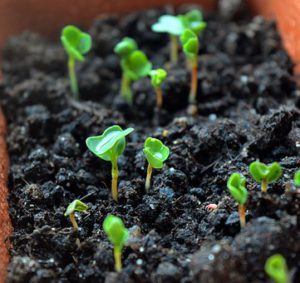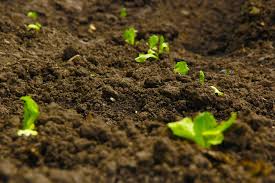Turning Your Backyard Garden soil into Organic

Backyard gardens are becoming more and more popular as many homeowners are seeing the need of finding ways to sustain themselves, especially during these times. Persons who would have never thought of growing a backyard garden are now getting their hands pleasantly dirty seeking to reap a good reward for their labor.
But as the need arises for more backyard gardens there is also the concern of growing food crops in such ways that will be of great benefit to our health. I believe if not all of us most of us are all too familiar with hearing stories of persons becoming ill because of food contamination.
These stories of food contamination have sparked such an interest in growing food crops in a much healthier way so if you’re interested in how this is done then continue reading.
Getting to the Root of the Problem
Without garden soil, having a backyard garden, and growing food crops on a wider scale such as farming would not be possible. The soil really does matter which is at the heart or root of having a garden that’s thriving while growing a crop that’s healthy.
Because the soil is one of the greatest factors to having much success the first step in the right direction is to ensure that our garden soil is healthy because beginning with healthy soil will make our time worth spending in our gardens so much more enjoyable as we see positive results.
One of the greatest challenges however that many backyard gardeners face is having the right knowledge when it comes to the right soil type. What is the right soil type and how can I make soil improvements if the need arises?
Understanding Garden Soils
This is a vast subject so what we will be doing is taking a look at some soil basics. Garden soils can either be sandy, clay, chalky, silty, peaty, or loamy.
Sandy soils

Sandy soils are soils that drain well, warm up fast in the spring hold very few nutrients, are easy to work with, and dry out fast. Sandy soils feel gritty to the touch so if your garden soil shows these traits chances are you have sandy soil.
Clay soils
Clay soils drain poorly and become hard when dry, when wet clay soils feel sticky and lumpy but have been known to retain nutrients. This soil is very hard to work with or cultivate and warms up slowly during the springtime.
Chalky soils
Chalky soils are well-drained, with large grains, this soil type contains alkaline and should be amended.
Silty soils
Because of their texture silty soils are easy to work with, usually have high nutrient content, feel soft to the touch, and hold moisture well.
Peaty soils
The texture of this soil type feels spongy and damp along with being dark in appearance. Peaty soils are known for their water-holding ability and heat up rather quickly during springtime. This soil has little nutrient content and is acidic.
Loamy soils
Loamy soil can be considered to be the almost perfect soil, this soil is slightly damp with a fine texture with a combination of silt, clay, and sand. Loamy soils warm up quickly in the spring, is nutrient-rich, retain moisture well but will allow excess to drain, and is easy to work with. This is the ideal soil for a backyard home garden.
How to make Organic Soil

The above mentioned gives a good idea of what soil type you have, in this section however we will be looking at how to turn your existing soil into organic but the last soil type on this list seems to be ideal, even though that’s the case you can further build your loamy soil to get the best results.
1. Building a compost pile
A great way to make organic soil is by creating a compost pile, though this process may take a while you will reap the rewards. Once your compost is finished can be added to your existing soil.
2. Sandy soils
To improve the quality of your sandy soil adding 3-4 inches of well rotten manure or other organic materials to your soil will make improvements.
3. Clay soils
Improve your clay soil by keeping spading and tilling at a minimum, add 2-3 inches of organic matter in the first top few inches of soil. Once this process is completed add 1 inch of organic matter each year. Adding leaf mold or well-rotten manure will also work wonders.
4. Chalky soils
To improve chalky soils work in organic materials such as peat moss, manure, compost, leaf mold, humus, or pine needle
5. Silty soils
To improve silty soils cultivate only the first top few inches of soil, work in 1 inch of organic matter each year, keep soil tilling at a minimum to avoid compaction,
6. Peaty soils
To make improvements to this soil type use of glacial rock dust, or organic matter that is rich can also be added to this soil. It is also recommended that drainage channels be dug for soils that contain high peat content.
The final word on how to make organic soil
It is good to know that we can take any soil and make it the ideal soil, a soil that will help to grow food crops in a safer way that’s great for our health. Growing organic is the way to go, this method of soil improvement has given good results so put this practice to use as you reap a good harvest that will promote your health.
About the author
Norman loves being in the garden, both at home and for his job....
he is 'Natures Little helper' being outdoors, growing his vegetables and flowers from an early age.
Now having spent over 22 years in the profession he want to give some of his knowledge to others...
his vast array of hints and tips you will find scattered over this site will help you no end growing plants in your garden.

Thank you, Norman, for this interesting article, our soil in the garden is clay, not easy to work with, we collect the leaves from our plum trees every year in autumn every and put them up on our veggie garden soil, we then cover them in winter and have nice composting soil in spring. To grow organic vegetables is so important these days, we know what we eating, that’s why compost is the gardeners’ best friend.
You are welcome and you are so right with what you have said. Composting is so amazing and does wonders, all the best to you have a good day.
Hi,
From my research online on how to make organic soil many people think that you can fill a raised bed with straight up dirt or compost, you don’t have the necessary ingredients in the soil to nourish your plants, retain moisture and to allow for proper drainage, the essential nutrients are in the soil recipe and you most likely will never need to feed your plants or fertilize them because all the nutrients are right in the soil. I rarely have any problems with pest or any diseases harming the plants.
Thank you.
Aluko.
Hello and thanks so much for commenting and for the insight, all the best to you, and have a good day.
Hi. I welcome the opportunity to comment on your page.
The page looks attractive with plenty of colour and it’s instantly clear what your web site is for. The intro draws the reader in nicely. I was confused in the chalk soil reference to ‘texture is large’ and ‘needs to be amended’ (presumably you’re suggesting it’s ‘treated’ – which is what we would say in the UK). I live in a heavy clay soil area and do not regard myself as an expert but we are always told that to break up the heaviness we should add lots of grit and sand to prevent clumping and improve drainage but also to add organic material like you say in the page. I tend to use chicken (dung) pellets as it’s easier – and anything from the compost heap I might have. Had to laugh on your Peaty soil paragraph as you suggested drainage channels are ‘drugged’ !!!. Also not sure what glacial rock dust is. If it’s available as a soil treatment, never heard of it – at least here in the UK. As an aside, my comments on the commercials in the right hand margin are that I was unclear who I would be supporting if I clicked the button against ‘we are happy for your support’ and also the commercials carry on well below the article itself which to me at least seemed to be overkill on the sales pitch aspect – but only my opinion.
Hope this is useful.
Thanks so much for commenting and for your help, all the best to you.
This is such a wonderful article Norman! I’ve always wanted to start a garden for some of the same reason you stated in your article. However the soil where we live isn’t the best in terms of being fertile but you seem to have covered every soil type and how to improve it here so I’ll definitely be saving these tips for future use!
Thanks so much for your kind words and I am so happy to help, all the best to you and have a good day.